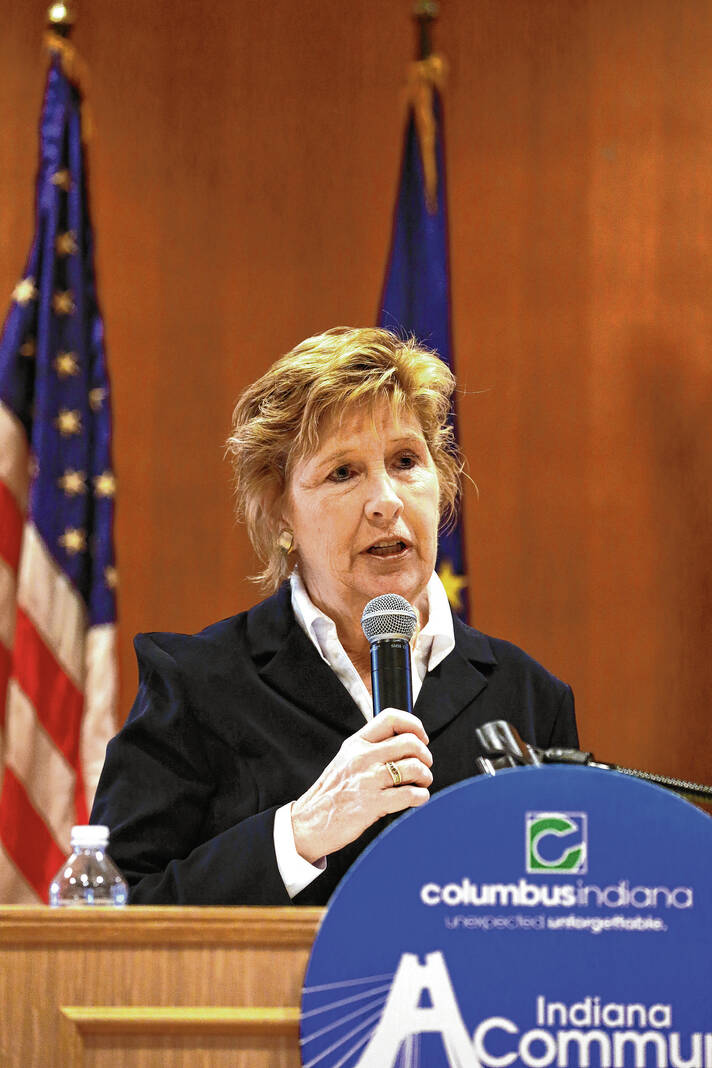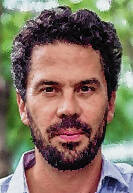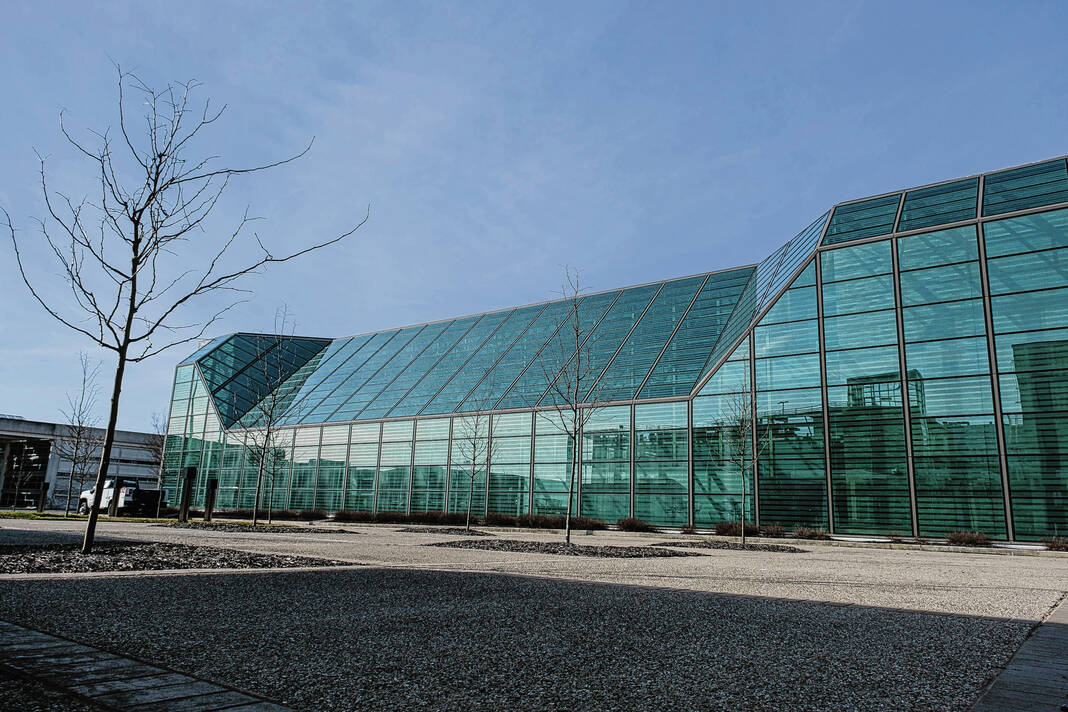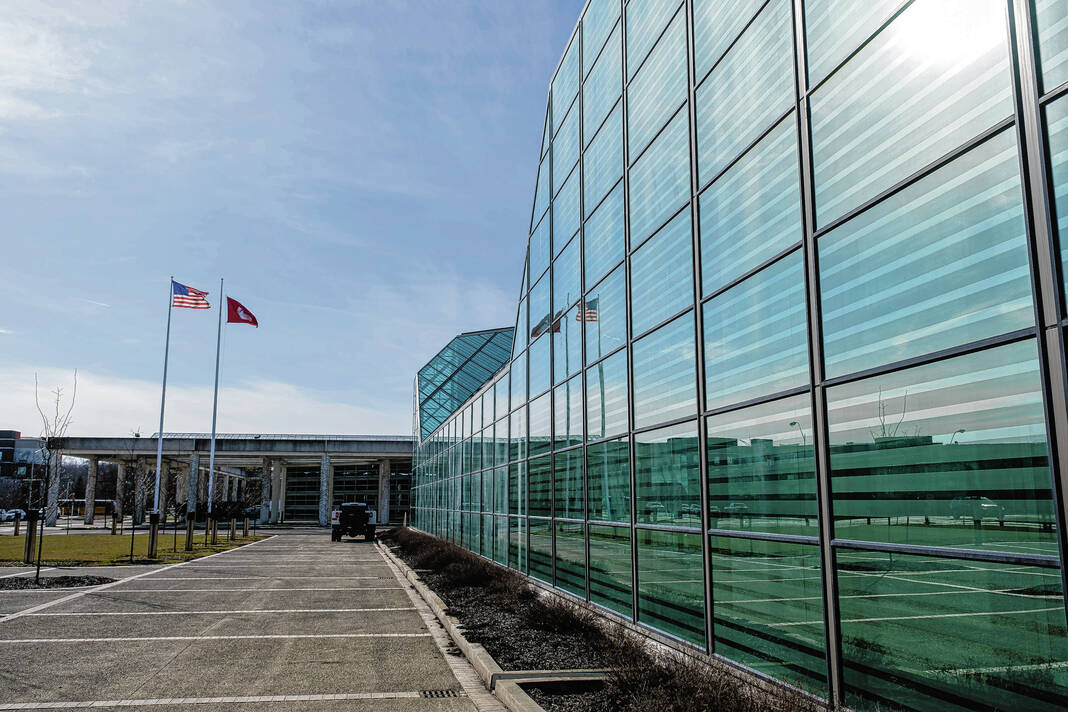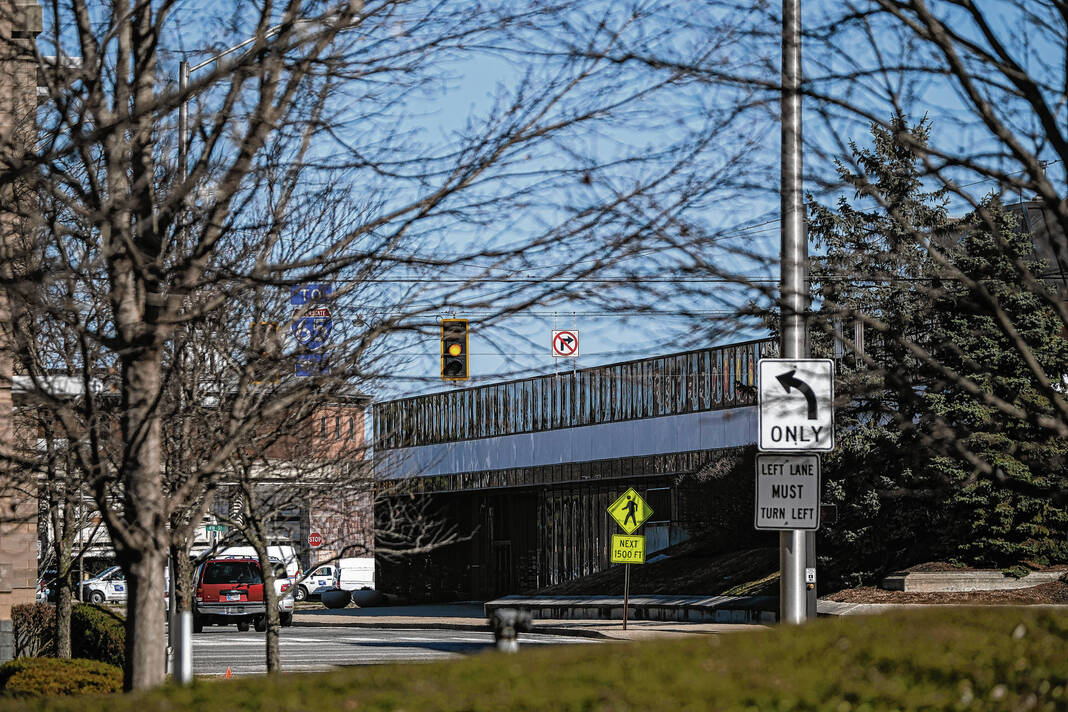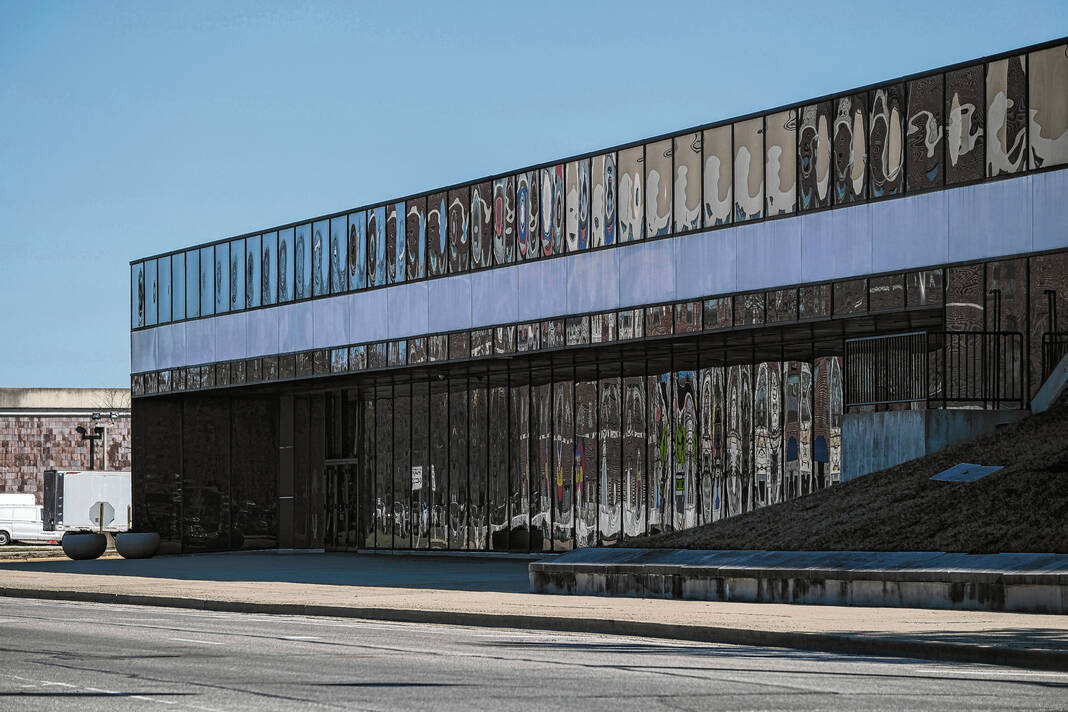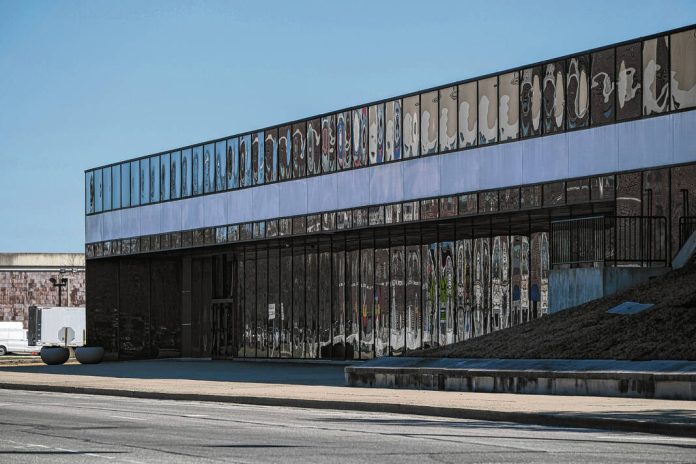
Mike Wolanin | The Republic A view of the former Sears building now owned by Cummins in downtown Columbus, Ind., Thursday, Feb. 29, 2024.
Local officials say they are planning to “rethink what downtown Columbus should look like” as the city adjusts to the post-pandemic landscape and evaluates how to move forward in the wake of Cummins Inc.’s decision to sell two large downtown offices that have been largely vacant for several years.
Some local officials have gone as far as to characterize the current juncture as a “pivotal moment” for the city’s downtown, which has weathered the economic upheaval of the COVID-19 pandemic with a new reality setting in.
“In downtowns across America and really around the world, there is a declining interest in commercial real estate,” said Richard McCoy, executive director of Landmark Columbus Foundation. “…I think Columbus is at a pivotal moment. Downtown is distressed, and you have two key properties that could change that.”
Earlier this week, Cummins Inc. said it is selling the Irwin Office Building and Conference Center and the Cummins Sears office building in the city’s downtown, “to offer the ideal work environment for our employees and align with the workplace needed.”
The two office buildings, which company officials said have been vacant since October 2022, take up nearly two entire blocks in the city’s downtown.
The Cummins Sears office building occupies the block surrounded by Fourth, Jackson, Third and Brown streets and includes YES Cinema. The Irwin Office Building and Conference Center, which is one of 44 National Historic Landmarks in Indiana, is located at the corner of Fifth and Washington streets.
With the two properties on the market, city officials said they plan to “take a second look” at efforts to activate downtown Columbus, which has long been a key part of the city’s economic development strategy.
“We’ve really lived the past couple of years with the changes that we’ve seen downtown post-COVID. This evolution isn’t happening just in Columbus. We see it nationwide,” said Columbus Mayor Mary Ferdon. “…I think work habits have changed, period. And so, from the city’s perspective, we need to proactively move forward and rethink what downtown Columbus should look like.”
‘Heart and soul of the city’
The decision by Cummins to sell the two offices comes nearly four years after COVID-19 swept across the community for the first time, upending life in Bartholomew County and ushering in a flurry of remote and hybrid work arrangements that show little signs of returning to the way things were in 2019.
Before the pandemic, downtown Columbus was bursting with workers, who would pour out of their offices and into nearby restaurants during their lunch breaks, pop into retailers along Washington Street, file into fitness centers to take yoga and spinning classes and grab drinks at local bars after work.
But downtown has grown much quieter since the pandemic hit, posing challenges to downtown businesses that have relied for years on foot traffic from downtown workers, many of whom are no longer working on-site full time anymore.
In spring 2020, Cummins instituted a work-from-home policy for many of its downtown workers during the initial wave of COVID-19 infections. When the company reopened its offices about two years later, many of the workers who were previously working full-time in downtown Columbus had “hybrid” working arrangements, which meant they would work part of the time on-site and part of the time remotely.
Cummins has said it “remains dedicated” to Columbus and “will continue to do our part to make this a more economically and socially vibrant city.”
While it is hard to say how many remote or hybrid Cummins workers have continued to live in Bartholomew County, the company is the largest employer in the area and estimates from the federal government show that the county saw a decline in population after the pandemic struck, which officials have partly attributed to local workers moving elsewhere to work remotely.
“We saw a decline in population of almost 2,000 during the pandemic,” said Steve Mohler, an assistant professor of management at IU Columbus. “…That was pretty substantial … and (the county) has not recovered to the level it was before.”
At the same time, people who left may be hesitant to move back to Columbus in part due to interest rates. In a bid to combat decades-high inflation, the Federal Reserve has increased its benchmark rate 11 times since March 2022, leading to significantly higher costs for loans for consumers and businesses.
“People were a lot more mobile in 2020 and even 2021 than they are now because mortgage rates were 3%,” Mohler said. “…People that have a home and 3% mortgage probably aren’t too excited to relocate for a 7% mortgage.”
Additionally, remote workers with young children also may be reluctant to return to the office full time and incur thousands and thousands of dollars in child care costs, Mohler said.
“Unless your job or something takes you there, you’re not going to just up and move to Columbus,” Mohler said. “I think we’ll need to be able to attract them in some form and hope the mortgage market improves.”
“The pandemic changed things, and it is difficult to get people to go back, to be perfectly honest with you,” Mohler added. “And that’s for economic reasons.”
City officials, who often refer to downtown as “the heart and soul of the city,” still are hoping to attract more people downtown.
Part of those efforts have involved the Columbus Riverfront Project and a series of mixed-use developments with apartments that have been announced or recently completed, including The Taylor just east of the Bartholomew County Jail, as well as another development planned near the intersection of 11th and Washington streets.
Ferdon said the city’s understanding is the target market for these developments includes a combination of millennials, single workers, younger couples without children and seniors who have decided to downsize, among others.
“It’s really critical for us to get people living and working downtown as much as we can,” Ferdon said.
At the same time, local officials are planning to reevaluate the Envision Columbus downtown strategic development plan, which has helped guide a lot of the downtown projects over the past several years but could not have predicted the impact of the pandemic.
“Some of the pieces (of the plan) still apply, but we do realize that the Envision project is now at least six years old, and so it needs to be updated or tweaked,” Ferdon said. “Our intention later this spring is to start that process of revisiting the downtown area. …We really see a need to sit down with all the new opportunities and just take a second look as to what we can do downtown to fit our next steps forward.”
“Businesses follow people, and we want to attract and retain talented people,” Ferdon added. “That is key to the future of Columbus and building a city which serves the next generation.”
Hotel conference center?
City officials are eyeing the Cummins Sears office building as the potential new site of a proposed hotel conference center in an effort to move forward with the project, which seeks to help activate the city’s downtown.
However, the project has faced a series of setbacks in recent years due amid rising construction costs and a pandemic that severely hobbled the hospitality industry.
City Redevelopment Director Heather Pope said earlier this week that the availability of the Cummins Sears office prompted city officials to reconsider the location of the proposed hotel conference center, largely because it is centrally located and offers the chance to extend the city’s entertainment corridor along Fourth Street.
The current proposed site for the hotel conference center is the block surrounded by Second, Franklin, Third and Lafayette streets in downtown, which the commission acquired through a property-swap agreement with Bartholomew County in 2022.
The city has submitted a letter of interest to Cummins “to let them know that we are interested in (the property),” Pope said.
“Generally, we all agreed that (the Cummins Sears office) would probably be a better location,” Pope said. “Now, what form that takes, I don’t know. And how we’ll proceed from here, we’re yet to figure out.”
Should the city decide to move forward with purchasing the Cummins Sears office, it would raise questions about what the future holds for the current proposed site, where the former court services building was demolished last year to make way for the hotel conference center.
Under the land-swap agreement, the commission took ownership of the block surrounded by Second, Franklin, Third and Lafayette streets, which previously housed the Bartholomew County Court Services building, and agreed to contribute $1.5 million to the construction of a new court services building south of the Bartholomew County Jail.
Officials said that they have not yet determined what they would plan to do with the current site that was acquired in the land-swap agreement with the county, as they are “still very much in the preliminary discussion/planning phase.”
As of now, it continues to be a parking lot for county employees, as it was prior to the land swap.
National Historic Landmark
While the Cummins Sears office building may already have a buyer, the Irwin Office Building and Conference Center is another story, as it is currently unclear who may be interested in the 90,794-square-foot office space, officials said.
The property, which was initially owned by Irwin Union Bank and Trust Co., was designed by famed Finnish-American architect Eero Saarinen in 1954, and features “nine opaque domes” that “act as giant lamp shades” and flooring in some areas with “1-inch thick glazed, split paving brick in a rustic buff color,” according to the Columbus-Area Visitors Center. The three-story glass arcade was designed by Kevin Roche and added in 1973.
While Cummins converted much of the building into office space, the former bank lobby was used by Cummins as a conference and hospitality center, as well as flexible workspace, until the pandemic struck. The company strived to maintain as much as possible of the original architecture and left many remnants of the former banking facility in place, according to the Columbus-Area Visitors Center.
First Financial Bank acquired the property after the demise of Irwin-Union Bank during the Great Recession.
“I think it represents the single greatest opportunity in the past 20 years for cultural and economic development in downtown Columbus,” McCoy said. “…It’s a National Historic Landmark. It’s one of the most significant buildings in America, and it’s tied to the Irwin and Miller family legacy, the heart of Columbus’ legacy. And it’s a property that demands careful attention and a thoughtful approach.”
Ferdon said the city has had conversations with Cummins about the property and will “work with them and any potential buyer to make sure that it’s next use fits its prominence in our city.”
But in the meantime, as the new normal for the community, particularly the city’s downtown, continues to come into sharper focus, city officials say they are ready to adapt.
“I think it shows that nothing ever remains the same, that changes happen, and that, as a community, we have to be able to evolve with those changes,” Ferdon said.


